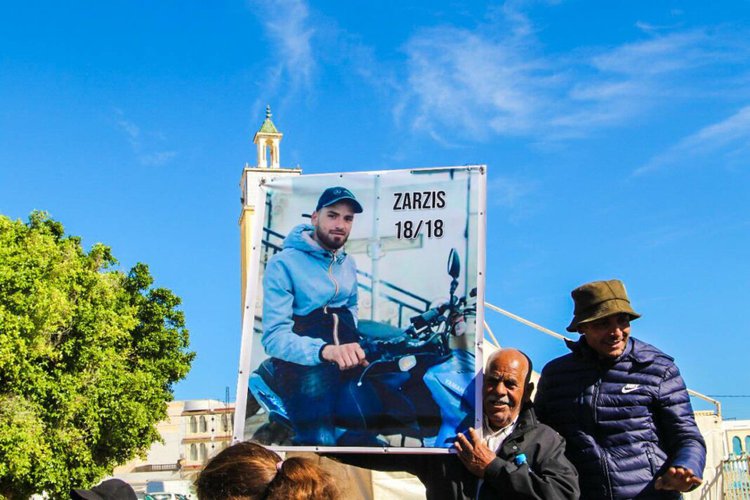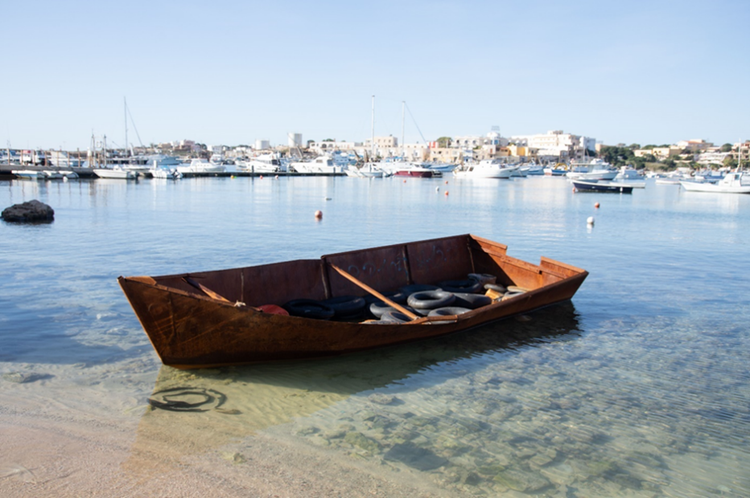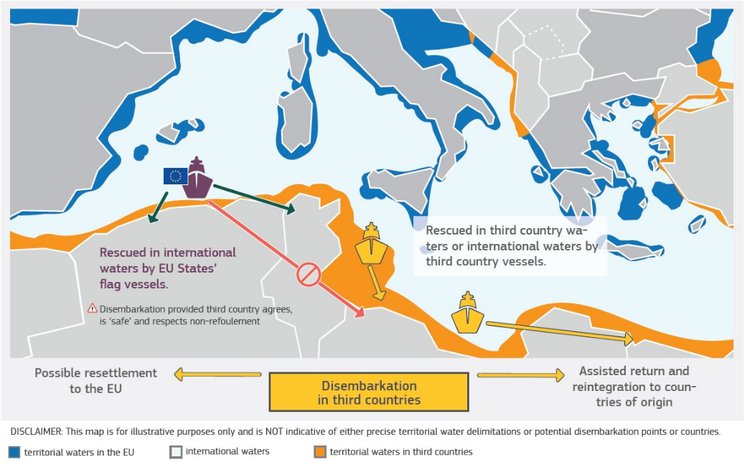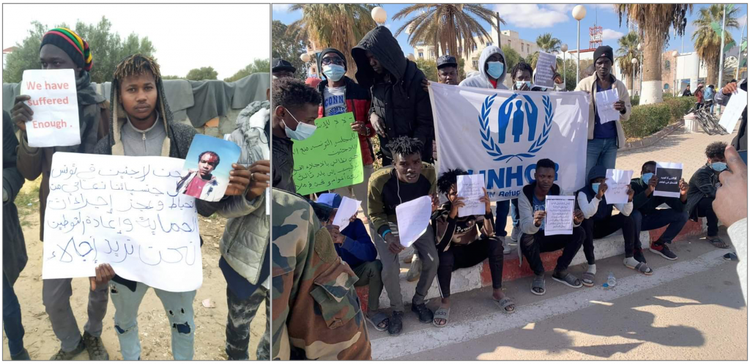New Developments Along the Tunisian Route
February 5th, 2023
First published in January 2023 by Civil MRCC in Echoes 4
Over the last two years, the number of people leaving Tunisia by boat to reach Italy has been increasing. This analysis describes the latest developments along this route, while placing them in the broader framework of European border outsourcing policies.
A route which is more and more dangerous
A growing number of shipwrecks
Since 2020, the number of shipwrecks and disappearances close to the Tunisian coast of boats carrying people on the move trying to reach Italy has been increasing. According to figures from the FTDES (Tunisian Forum for Economic and Social Rights), between the beginning of the year and the end of November 2022, more than 575 people died on this crossing. To this figure, one must also add the "invisible" shipwrecks, those countless boats which disappear without leaving any traces.
In Tunisia, morgues are overflowing with the bodies of migrants who wash ashore as well as those recovered by the coast guard or Tunisian fishermen. According to Judge Mourad Turki, spokesman for the courts of Sfax, from January 1 to December 31 2021, the morgue of the regional hospital (Sfax) received 300 bodies recovered at sea. Between January and April 2022, 125 bodies were recorded in the same hospital. It should be noted that most of the bodies, when it is possible to identify them, are the bodies of non-Tunisian migrants, mainly from West and Central Africa.[1]

This morgue is so crowded that bodies are regularly laid on the ground without refrigeration, despite the stifling temperatures and the health risks, not to mention the attacks on the dignity of the deceased. The body identification system is deficient, with most bodies being buried anonymously. This failure also concerns Tunisian nationals, as evidenced by the recent shipwreck in Zarzis in September 2022 (see dedicated article in Echoes #3), during which bodies were buried without DNA identification.
An increasing number of West and Central African migrants
In recent years, the population sailing the Tunisian route has changed, with a clear increase in West and Central African people taking this route since 2020. While in 2020, Tunisians accounted for nearly three quarters of those intercepted by the Tunisian coast guard, 2022 FTDES figures show that they now account for only half, with non-Tunisians gradually becoming the majority,[2]and particularly Central and West Africans. Long considered a country of origin, Tunisia is indeed also a country of destination for many migrants, but also increasingly a transit country.
Since the 1960s, Tunisia has welcomed migration from sub-Saharan countries, mainly made up of French-speaking migrants who came to study or work in North Africa. Most arrive in Tunisia by air, on a regular basis, with several nationalities such as Ivorians, Guineans, Gambians and Malians being exempted from applying for visas for a stay of less than three months.
Especially since 2018 and the strengthening of cooperation between the EU and the Libyan Coast Guard, Tunisia tends to become a country of transit both for a migrant population fleeing Libya, as well as for a population arriving in Tunisia directly from their country of origin. While some migrants come to Tunisia with the ambition of attempting the sea crossing to Italy, ever more people leave Tunisia by boat after having lived there for several years, fleeing a deteriorating economic situation and various forms of insecurity (cf. part C).
This is the case especially in the region of Sfax, where there exists a large migrant population from West and Central Africa. Since a significant number of these people are living in an irregular administrative situation and are criminalised by authorities, the preparation for the crossing is often more complicated than for Tunisians. Self-organised trips are rare and boats are often more precarious and overcrowded.
A route difficult to monitor, with particularly dangerous boats
The Tunisian route is particularly difficult to monitor for civil actors. The closer to Tunisian shores, the blurrier and more hidden the information is on what happens at sea. Civil air assets especially are hindered from entering the militarised Tunisian airspace, which includes the larger area of standard routes from Tunisia towards Lampedusa. This is one of the main reasons why a huge number of attacks and interceptions of boats leaving Tunisia remain witnessed only by the ones being threatened. Moreover, the usage of satellite phones is criminalised in Tunisia, which prevents people on the boats from alerting the authorities or the Alarm Phone as they get away from the coast.
Moreover, a type of particularly dangerous boat has appeared since last summer (see interview with RESQSHIP). Made of thin iron plates and assembled together, these metal boats respond to recent raids on wooden boat factories. These boats are mostly used by migrants from West and Central Africa, departing from Sfax. Although these boats are promoted as "safe", they are very unstable and can easily fill with water and capsize at any time. Many iron boats reported to the Alarm Phone after leaving from Tunisia have been wrecked or are still missing. These boats are also difficult for NGOs and authorities to rescue due to their instability and their sharp edges, which can damage sponsons.

Tunisian coast guard attacks and dangerous manoeuvres
As documented by several Tunisian and European civil society organisations, the Tunisian Coast Guard has been accused on numerous occasions of being involved in dangerous manoeuvres which have cost dozens of lives. This phenomenon is not new: already in February 2011, Tunisian survivors who had tried to reach Italy by boat had accused the Tunisian Coast Guard of having "deliberately rushed" their boat, leaving 5 dead and 30 people missing in international waters.[3]
In recent months these attacks have accelerated, increasingly targeting Tunisian and non-Tunisian migrants. Alongside other Tunisian civil society organisations, the Alarm Phone network has collected numerous testimonies, photos and videos published on social media networks which testify to the violent behaviour of Tunisian authorities during their interception operations at sea.
On December 19th 2022, a press release, signed by more than fifty associations, was published to denounce this violence: « Beating people with sticks, firing shots in the air or in the direction of the engine, knife attacks, dangerous manoeuvres to attempt to sink boats, demanding money in exchange for rescue… The practices of the Tunisian coast guard as reported by the migrants who have encountered them are more than alarming. These practices kill, as was the case last month, when a migrant boat was, according to survivors, violently rammed by the Tunisian National Maritime Guard. Following this attack off the Tunisian town of Chebba, reported by various media, three children drowned.”[4]
These violent behaviours, which are encouraged by the border externalisation policies of the European Union and its member states, participate in making the Tunisian route more and more dangerous. In spite of these obstacles, however, many migrants still manage to reach the Italian coast, the vast majority of them autonomously (cf. dedicated article in Echoes #2).
A key partner for European Member states in migration control
Italy-Tunisia readmission agreement
Cooperation between Europe and Tunisia is primarily embodied in bilateral agreements, mainly between Tunisia and Italy, the country on the front line of arrivals from the Tunisian coast. Italy and Tunisia have signed several agreements for the joint management of migration, border control and the repatriation of citizens of the two countries in an irregular format: in 1998, in 2009, in 2011 and again in 2017. Some of these agreements, however, have never been published by the administration.[5]
The repatriation agreement between Italy and Tunisia is among the few which are operational, and the repatriations of Tunisians constitute an important percentage of the total number of removals. Indeed, with approximately 1,922 Tunisians repatriated in 2020 and 1,872 in 2021, repatriations to Tunisia account for 73.5 percent of the total number of repatriations carried out by Italy.
Immigration from Tunisia has been and still is perceived as “economic” immigration: it is generally believed that Tunisian citizens have neither the will nor the need to seek international protection.
This idea, far from the reality as continuously attested to by Tunisian and international civil society organisations, is extremely entrenched and has strongly influenced Tunisia's migration management practices and policies. It has even been enshrined in the decision to place the country on the list of 'safe countries of origin', which makes it very difficult for Tunisian nationals to access international protection in Italy.
Millions to protect EU borders
In 2012, Tunisia signed a "privileged partnership" agreement with the EU, which was translated into an action plan for the period 2013-2017. The plan first mentions the opening of negotiations for the conclusion of a "Partnership for Mobility": in exchange for a policy of visa facilitation (reserved for a small, ultra-qualified elite of Tunisians), Tunisia would undertake to sign a readmission agreement by which it would facilitate the readmission not only of Tunisians expelled from Europe, but also of third-country nationals who would have transited its territory before reaching the EU.
Whereas the Tunisian authorities have so far refused to sign this agreement, they have accepted millions to secure EU borders. Between 2016 and 2020, more than 37 million from the EU Trust Fund for Africa was granted to Tunisia for the “management of migration flows and borders”.
In a document leaked by Statewatch[6]detailing the 2021-2027 EU-Tunisia strategic priorities, the EU Commission proposed to allocate up to €85 million intended for Tunisia for 2021 and 2022 to cover “border management, migration governance, voluntary returns to and from Tunisia, multi-country actions on legal migration and the fight against migrant smuggling”. Despite some decorative projects concerning legal migration, the objective is clearly to prevent arrivals on European coasts.
Italy has a leading role and responsibility in supporting the migration control apparatus in Tunisia. Since 2017, the country has invested around 75 million euros for migration management projects. The projects are mainly financed through the Migration Fund (formerly known as the Italian Africa Fund), established in 2017, and through the Return Reward Fund established in 2019.
Nine of the projects financed concern support for border control through police training, the provision of equipment for data collection and management, technical support, equipment and maintenance of vessels for coastal patrolling and other tools for tracking and monitoring movements. For these activities, Italy allocated 58 of the above-mentioned €75 million. The remaining funds are earmarked for addressing the root causes of emigration, the reintegration of returnees and for projects aimed at the protection of refugees and asylum seekers through funding to the UNHCR in Tunisia.
A growing cooperation at sea
In recent years, the European Union and Italy have focused an important part of their support to Tunisia in the field of maritime surveillance. A good example of cooperation between Italy and Tunisia in this field is the “Support for border control and management of migratory flows in Tunisia” project. Implemented by the United Nations Office for Services and Projects (Unops) in Tunisia and the Italian Ministry of Foreign Affairs, this project, which started in May 2021, foresees the maintenance and refurbishment of six Tunisian Coast Guard patrol boats.[7]
The Tunisian component of the EU Border Management Programme (BMP) Maghreb, funded by the EU Emergency Trust Fund for Africa (€ 30 million for the period 2018-2023) and implemented by ICMPD, also focuses on strengthening the Tunisian Garde Nationale Maritime (Coast Guard). The project aims at establishing an integrated border surveillance and coastal communication system, providing operational equipment to the Coast Guard (including the installation of radars) and increasing their capacity through training sessions.
The increased interception capacity of the Tunisian Coast Guard is evidently directly proportional to Italian and European support. According to information gathered by the Tunisian Forum for Economic and Social Rights (FTDES), there have been more than 29,000 interceptions at sea since the beginning of 2022. At the same time, the number of attacks on migrant boats dramatically increased. The Tunisian Coast Guard is directly trained, equipped and financed by the European Union, despite its documented violent practices.
Cooperation between Frontex and Tunisia remains unclear. In 2021, Frontex reported that “no direct border related activities have been carried out in Tunisia due to Tunisian authorities’ reluctance to cooperate with Frontex”. Since May 2021 Frontex has been flying a drone, in addition to its different assets, monitoring the corridor between Tunisia and Lampedusa on a daily basis.
However, while it is clear that Frontex is sharing data with the Italian authorities and that Italian authorities are sharing info on boats which are on the way from Tunisia to Italy with the Tunisian side, the communication and data exchanges between Frontex and Tunisian authorities remain uncertain.
So far, it has not been possible to verify if Frontex has direct contact with the Tunisian Coast Guard as it is the case with the Libyan Coast Guard. Even if most of the interceptions happen close to Tunisian shores, some are carried out by the Tunisian Navy outside of territorial waters. As Tunisia doesn't deploy any air assets in this area, it is quite likely that the information on boats in distress comes either from Italy or directly from Frontex.


Tunisia, a future disembarkation platform?
An additional step in the outsourcing of its borders, the transformation of Tunisia into a disembarkation platform is a project that the European Union has long dreamed of.
On June 28, 2018, taking up a joint proposal by UNHCR and IOM, the European Council invited the Council and the EU Commission to develop a proposal for the management of migration flows through the establishment of 'controlled centres' (to be established on the territory of EU Member States) and 'regional disembarkation platforms' (to be established outside EU territory).
Shortly afterwards, in July 2018, the Commission presented a non-paper on regional disembarkation platforms in a third country.
According to this document, the regional disembarkation mechanism would be intended for migrants rescued in international waters or in territorial waters of third countries by vessels flying the flags of a member country or third countries.
The European Commission's non-paper referred to the possibility that disembarkation platforms could be established in North African countries, subject to the negotiation of an 'ad-hoc and customised package' for each third country offering to host a disembarkation area. UNHCR aimed to contribute to the negotiations by committing to strengthening national asylum systems, including the regulatory framework and protection mechanisms.

Although Tunisia emphatically rejected this proposal at the time, the increasing involvement of UN agencies (UNHCR and IOM) on its territory shows the growing externalisation of European borders in the North African country.
In the recent Action Plan for the Central Mediterranean, published by the Eu commission last November, the Commission refers to Tunisia both in terms of reinforcing the country’s capacities in monitoring and managing its maritime borders, but also strengthening the presence of UN agencies and a system of migrants and refugees reception in the country.
A country which by no means is “safe”
Economic, social and political situation
The current political and economic situation in Tunisia is affected by the continuous political unrest since the dissolution of the parliament in July 2021. This crisis was aggravated by the Covid-19 pandemic and the Russian military intervention in Ukraine. The consequences of this crisis are translated into austerity measures taken by the government which are enforced by the International Financial Institutions such as the International Monetary Fund. These austerity measures do not solve the many issues such as the rise in unemployment rates as well as the increase of the prices of basic goods, especially food.
Moreover, despite a strengthening of civil society in the aftermath of the 2011 revolution, Tunisia is far from being respectful of people's rights. Freedom of expression, of the press, of assembly and of religion are not fully guaranteed, nor is gender equality. Police brutality did not cease to occur in the few last years with several cases of assassination of young people and documented cases of torture.
This police brutality affected different social categories such as people from marginalised areas or persons from the LGBTQI+ community. Under Tunisian law, consensual sex between people of the same sex is criminalised and punishable by up to three years in prison.
The situation of migrants, asylum-seekers and migrants
The status of migrants in Tunisia is largely undetermined and is aggravated by the legislation on irregular stay, which exposes migrants to detention, deportation, and residence penalties. Many migrants living in Tunisia are also suffering from the deteriorating economic situation, the lack of access to health and education but also anti-black racism, which is socially rooted in Tunisia. Many cases of physical violence have been recorded and culminated to murder cases such as of Falikou Coulibaly, the president of the Ivorian community in Tunisia, in 2018.
While Tunisia has ratified the Geneva Convention, the right to asylum has not yet been introduced into the Tunisian legal system. With the absence of a legislation that regularises the right to seek asylum, the UNHCR is the entity that provides international protection in Tunisia since 2011. Various civil society organisations have extensively documented obstacles to applying for asylum, lack of transparency and guarantees during the procedure for determining refugee status, as well as discrimination based on nationality. Refugees and asylum seekers do not have access to work and are left in a very precarious situation. They cannot access education, health, and psychological support even though many of them had been in Libya facing torture, rape, and abuse.
Tunisia has also been accused several times of violating the principle of non-refoulement. One of the rarely-publicised cases took place in September 2021, when several migrants, mainly from West and Central Africa, were deported to Libya after they were intercepted by the Tunisian Coast Guard.
The refugee or asylum seeker card issued by the UNHCR does not provide any protection against detention or deportation to the country of origin. This is for example the case of Slimen Bouhafs, a refugee in Tunisia, who was deported to Algeria in August 2021 despite being under the protection of the UNHCR.
From “safety” to increased border externalisation
Despite all the evidence that Tunisia is not a safe country, the European Union tends to claim the opposite in order to justify the outsourcing of its migration policies. The safe third country concept, already introduced in the 'Asylum Procedures Directive' (Directive 2005/85/EC) is indeed central to the European Union's border externalisation strategies. Its application allows the return of asylum seekers to a third country considered safe, without an actual assessment on the merit of their asylum claims.
The directive currently in force provides that Member States may consider a third country safe if a number of requirements relating to the respect of fundamental rights are met, such as the absence of risk of persecution for the applicant, the respect of the principle of non-refoulement and the possibility for the applicant to apply for protection and, if accepted, to receive adequate protection in accordance with the Geneva Convention.
The member state only has to demonstrate an actual link between the asylum seeker and the country of return.

The recast proposal of the 'Asylum Procedures Directive' presented in 2016 by the Commission aims at extending the scope of the safe third country concept, allowing the EU member states to apply the concept after an individual examination that ascertains the asylum seeker’s connection with the country, where transit or stay in the country is a sufficient connection. Thus, any person arriving in Italy by sea and who can be proved to have departed from Tunisia could be deported back on the pretext that he or she would benefit there from sufficient protection.
This analysis shows the stakes involved in the recognition by European states of Tunisia as a safe third country. By promoting this concept, the EU is seeking to gradually relocate the asylum claims of people on the move reaching the European coast to Tunisia. This is also the concept that the European Union is using to try to make the disembarkation of people intercepted or rescued in the Mediterranean in Tunisia acceptable. The scenario of the transformation of Tunisia into a disembarkation platform tends to become a reality, that for the moment, only the reluctance of the Tunisian authorities and the opposition of civil society prevent from materialising.
The CMRCC denounces this dangerous, illegal, and inhumane policy. While promoting freedom of movement for all, we will continue to document all the reasons why Tunisia cannot be considered a safe place for disembarkation under any circumstances.
Title image: Tunisia-3913 - Where did the water go..... (archer10 (Dennis)/ CC BY-SA 2.0)
Footnotes
- La Presse.tn, « Sfax | Faute d’inhumation des corps des migrants clandestins décédés en mer : La morgue de l’hôpital débordée », 5 mai 2022 ↩
- Cf. FTDES monthly reports « Rapport des mouvements sociaux, suicides, violences et migrations » ↩
- Le Monde, Des rescapés accusent les garde côtes tunisiens d'avoir précipité leur naufrage, 15 février 2011 ↩
- Press release, Deadly policies in the Mediterranean: Stop the shipwrecks caused off the coast of Tunisia, 19 December 2022 ↩
- See agreements published on the website https://sciabacaoruka.asgi.it/ ↩
- https://www.statewatch.org/news/2022/april/eu-tracking-the-pact-tunisia-refuses-cooperation-with-frontex-but-will-set-up-an-integrated-border-surveillance-system/ ↩
- https://sciabacaoruka.asgi.it/wp-content/uploads/2021/03/Concept_note.pdf ↩